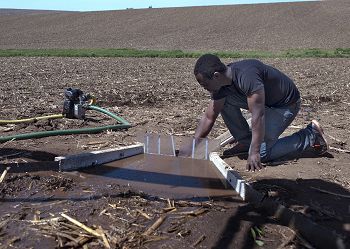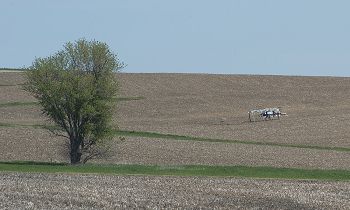Research Foci
Human activities have drastically transformed the critical zone of IMLs. Modification of the landscape has resulted in the disturbance of soil structure, dramatic losses of wetlands and native vegetation, channelization of streams, and large nutrient loadings. Development of this landscape has likely reduced water's storage and residence time, and these shifts may also affect the landscape's resilience to future impacts associated with ongoing human activity or with extreme weather events caused by climate change. As a result, many believe this trajectory of rapid land use change is unsustainable for maintaining and increasing CZ services.
Studying sediment transport in the Clear Creek Watershed in Iowa.
Studies in the Sangamon River Basin is led by researchers at the University of Illinois at Urbana-Champaign.
The central hypothesis for the IML-CZO is that, through human modification, the critical zone of IMLs has passed a tipping point and has gradually shifted from being a transformer of material flux with high nutrient, water, and sediment storage to being a transporter of material flux with low nutrient, water, and sediment storage.
Theme A: Geologic Timescale Processes: Glacial Legacy to Future Climate Change
Key Question: How does the coupled interaction of geologic materials, landscape form, and the soil continuum respond to climate, vegetation, and human activities in the critical zone?
An evaluation of how the system has responded to past change is key to understanding the resilience of soils in the context of current and future human-driven change. Understanding the direction of landscape and soil evolution in the IML-CZO prior to intensive human activity will allow us to address the question “How do current and future anthropogenic land use change (and climate change) compare with natural Quaternary and Holocene environmental change in terms of effects on physical processes in the critical zone?”
Theme B: Short- and Long-Term Dynamics of Soil Organic Matter
Key question: What is the dynamic relation between active and stabilized forms of soil organic matter (SOM) in IMLs and how does that relationship vary in activity centers and activity intervals? What are their effects on biotic and abiotic activities as they relate to SOM storage?
Soil organic matter (SOM) is the elixir of life in the critical zone, as it is central to sustaining both crop productivity and ecosystem services. Intensive agriculture causes a dramatic decline in SOM storage on the landscape. We hypothesize that intensive agricultural management can significantly modify the interrelated processes that affect SOM storage. The interactions of these processes influence the chemical reactivity of SOM and its structural characteristics, with potentially significant implications for the soil structure and residence times of solutes and solids.
Theme C: Coupled Surface Water – Groundwater Hydrology and Biogeochemistry
Key Question: How does the coupled interaction of surface water and groundwater control fluxes of water and solutes within the critical zone? How do the signatures of key materials that are exported (e.g., SOM and DOC) relate to those stored in the landscape?
Human activity is driving drastic changes in the hydrologic cycle through both short-term replumbing of the hydrologic system and long-term changes in both water availability and climate. In the short term, land use change alters hydrologic fluxes, including aquifer recharge and the stream response to storm events (e.g., flashier systems). At larger spatial and longer temporal scales, water withdrawals result in widespread drawdown of regional aquifers (e.g., the Ogallala aquifer in the Midwest). Finally, anthropogenic climate change is expected to redistribute water both spatially and temporally on the earth’s surface. We hypothesize that engineered drainage reduces the residence time of water and its associated suspended/dissolved loads in biogeochemically active locations of the critical zone. We will predict fluxes of water through surface and subsurface domains with isotopic tracers to characterize both physical residence times and integrated biogeochemical signatures from the land surface through soils into the fluvial network, including interactions with deeper groundwater.
Theme D: Water, Soil, Sediment and Landscape Connectivity: Short- and Long-Term Budgets
Key Questions: How are the sources, fluxes, and sinks of sediment in IMLs distributed in space and time? How do geomorphic, biogeochemical, hydrologic, and human processes interact with sediment production, transfer, and storage rates?
Sediment dynamics shape the landscape, influence soil characteristics, determine the form of alluvial river channels, and control in-stream habitat. Many channels throughout this region, including the headwaters of Clear Creek and the Upper Sangamon River basin, have been channelized to improve drainage and facilitate the use of large farm equipment near streams. Understanding the connections of landscape and stream processes will aid in the understanding of channel response to human modification. Our hypothesis is that sediment dynamics depend on the extent and distribution of variations in the landscape.
Theme E: Integrated Modeling and Critical Zone Services
The IML-CZO will use an integrated modeling approach that provides a framework for integrating high-resolution data (e.g., LiDAR, hyperspectral imagery) and event-driven dynamics shaping and shaped by long-term dynamics to provide a broader scale prediction and assessment framework. This effort will build upon the extensive modeling experience in our team and also draw upon other available models in collaboration with other CZOs.
Studies in the Sangamon River Basin is led by researchers at the University of Illinois at Urbana-Champaign.
University of Iowa researchers are collaborating with colleagues from the University of Tennessee-Knoxville as they work to understand processes in the Clear Creek watershed.
Soil sampling in a field near South Amana, Iowa.
Explore Further




